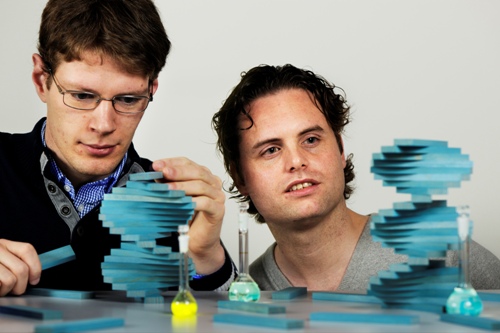
Researchers at Eindhoven University of Technology (TU/e) have succeeded in monitoring and controlling a molecular self-assembly process via different pathways. While it was formerly thought that the molecules form the right structure by themselves, this research shows that the assembly process can follow different pathways yielding different structures; in this case polymer chains with left- and right-handed helical directions. This new knowledge is of great importance for the understanding of supramolecular polymers, in which small differences in the way the molecular building blocks are organized can have a large influence on the properties of the resulting material.
Molecular building blocks form a supramolecular structure by arranging themselves through the molecular self-assembly process. Manipulating the molecular self-assembly process principles leads to the development of novel materials with innovative properties, for instance, a self-repairing coating. Since the way of self-assembly of the building blocks plays a major role in the properties of the resulting materials, a slight difference in their assembly can result in materials with unique properties.
In the experiment, the research team studied a molecular building block called S-chiral oligo (p-phenylenevinylene) or SOPV utilizing pectroscopy. SOPV initially self-assembled into unstructured clusters and then into well-arranged left-handed helical structures look like a spiral staircase. Earlier, it was believed that a molecule can self-assemble only into a single end-product and the process’ intermediate steps are not significant and cannot be studied due to their rapid occurrence.
According to the TU/e research team, intermediate process steps are highly significant, as they guide to different variants. For instance, rapid occurrence of SOPV’s self-assembly process produces spiral staircase structures featuring an opposite helical direction. However, when tartaric acid is added temporarily to the SOPV molecules, the assembly process is forced totally towards this alternative structure. In-depth analysis demonstrates that these two helical forms battle for the available molecular building blocks.
The article Pathway Complexity in Supramolecular Polymerization was published online on January 18, 2012 on the Nature website, and will also appear in the printed edition in the near future. The authors are Peter Korevaar, Subi George, Bart Markvoort, Maarten Smulders, Peter Hilbers, Albert Schenning, Tom de Greef and Bert Meijer, all at Eindhoven University of Technology. The DOI number is 10.1038/nature10720.

No hay comentarios.:
Publicar un comentario